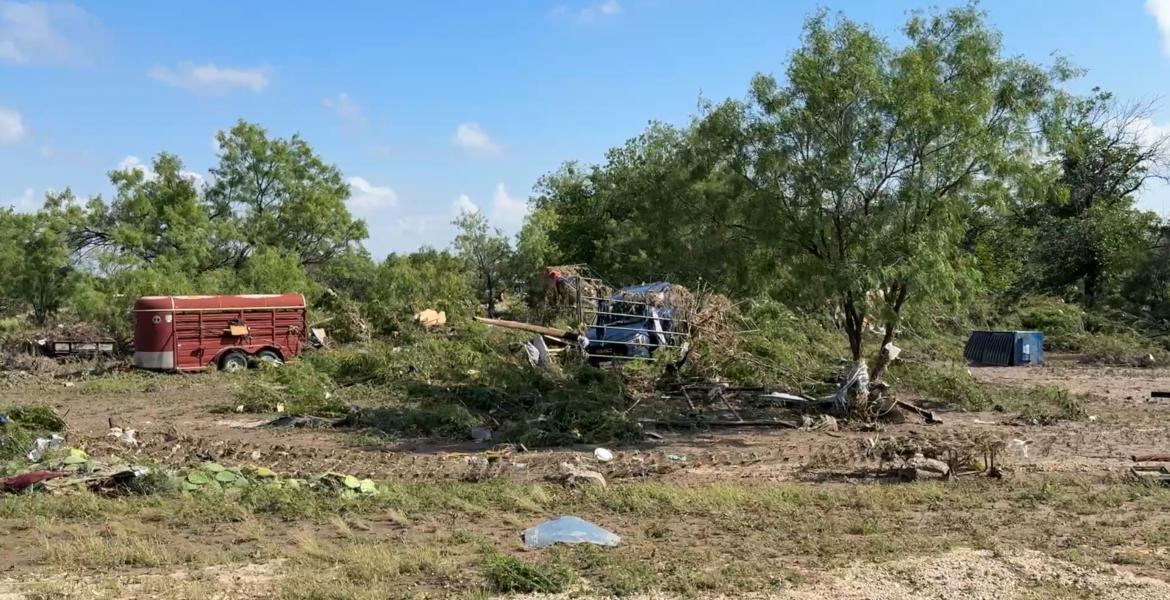‘I’m a guy,’ says Luis Urteaga, Pharamacy Instructor at Howard College. “I don’t know what pain is. So say I go to the emergency room for a stubbed toe and I’m asked to rank that pain on a scale of 1-10. I might say an eight,’ he says, hypothetically over-exaggerating for exemplary purposes.
‘At the same time, there’s a woman upstairs with an OBGYN that’s in labor. She just said eight as well,’ Urteaga continues. ‘So referencing that eight—which registers for both stubbing a toe and for giving birth—a physician is calculating what strength of pain medication the patient is given,’ Urteaga concludes.
“We look at clients instead of patients,” adds Chelsea Ashton, Coordinator for Concho Valley CARES (Community, Action, Resources, Empowerment, and Success) “and I think it becomes more of ‘the customer’s always right,’” she says.
“It’s retail,” Sara Lummus adds in, her statement immediately being picked up by Urteaga and Ahston. Lummus is the Pharmacy Director of Baptist Retirement Community and has been actively involved with the Alcohol and Drug Abuse Council of the Concho Valley (ADACCV) since 1988. She is currently an ADACCV board member.
“If I wanted to get his [my husband’s ADHD] medication, I would know to go in and exactly what to describe to the doctor because I can go on webMD.” Ashton continues. “And there’s no way for them to disprove it, because as Luis said, there are those things you can see and those things that are on the inside.”
Luis Urteaga had just made mention of how today, pain is being referred to as “the fifth vital sign.”
“[The naming of pain as the fifth vital sign] is an oxymoron, because vital means essential, and sign—the difference between a symptom and a sign, a sign you can see, a symptom you feel,” Urteaga said.
“That’s something that’s not objective,” Urteaga states, “it’s subjective, and that’s something that is a core difficulty [with the doctor’s assessment of the proper medication to prescribe today],” he continues. “And it’s a difficulty in a service, to where now it’s geared toward pleasing the patient instead of being geared towards treating the patient.”
Returning to the previous example, Urteaga expounds upon the problem, “If I have a stubbed toe and for me it’s the first time I feel that pain, maybe I don’t need an opiate, maybe I just need some over-the-counter Motrin and I’ll be fine. “
But the medical industry has become so focused on alleviating patient pain, that a patient can complain that their prescriptions aren’t high enough or aren’t working to the point that it jeopardizes the physician’s profession, Urteaga continued.
Traditionally, the four vital signs of heartbeat, breathing rate, temperature, and blood pressure have been most pertinent in presenting a patient’s case. But in 1995, a study was conducted that would change the way medical professionals thought about patients and pain indefinitely.
The SUPPORT (Study to Understand the Prognoses and Preferences for Outcomes and Risks of Treatments) study, which observed patients near death, revealed that a large number of those patients were suffering from minor to immense pain 50 percent of the time in their last days.
What ensued following this finding was a push for revised pain management practices and a campaign to assess and treat pain as a part of normal practice.
Soon thereafter, smiley face charts and the infamous pain scale spread through the nation, appearing in emergency rooms and examination stations throughout the U.S. and beyond.
While it is generally accepted that the results of the study provided insight into an area of legitimate concern for the wellbeing of patients in severe ill health, the proliferation of pain management and all the prescription pads that come along with it was severely underestimated.
“Some of the strongest pain medications that are offered in prescription are opiate derivatives,” Urteaga says, “and out of the whole world, the U.S. has 80-85 percent of all the opiates prescribed.
“A good question that you can also always ask is that when it comes to pain medication, are we the only ones that have pain?” he questions.
“We also, as compared to other cultures, deal with pain a little differently,” Ashton contributes. “Others use more holistic medicine first,” she says, noting that the method in the states often begins with the smiley face chart and ends with the prescription pad.
But the real concern comes when the impact is investigated.
“Hydrocodone is the number on abused [prescription] drug in Texas,” Lummus says. Opiates in general tend to top that list, and may include Vicoden, Valium, Loritabs, Ocycontin and other such pills.
“Even codeine cough syrup is abused,” adds Ashton. “That’s a big thing in hip-hop music. Miley Cyrus has a new song where she says ‘I’m high on perp,’ and that’s what she’s talking about.”
The spread of prescription pills over the past decade has become a cause for concern among drug prevention/rehab organizations and law enforcement alike, and all groups state that there are several misconceptions surrounding prescription drug use.
“I think it’s [prescription drug abuse] become a problem because maybe people think that it’s not as dangerous because doctors prescribe them,” says Lieutenant Fincher of the San Angelo Police Department. “They’re easy to come by. Prescription fraud is also a problem the SAPD sees frequently,” he says, adding that the problem fluctuates.
Fincher recently identified prescription drug abuse as one the largest up-and-coming issues in the United States. The scope of the problem, however is difficult to gage, as the drugs are considered legal in the right hands.
“We do have issues in the Concho Valley…we know that there are some issues with kids selling prescriptions to each other at school, especially ADHD medication and stuff like that,” Ashton says. “Especially here in San Angelo, we have a problem with prescriptions being sold on the street.”
Concho Valley CARES does a survey each year of 7th-12th grade youth in Tom Green County. The survey is completely anonymous and conducted online, and results are assessed by ASU, which does a statistical analysis to adjust for margin of error.
For 2012, the results were more positive than in previous years, indicating a dip in either prescription drug use, or in how forthcoming students are in their answers. Results from CARES are reported as follows:
CARES asks adolescents all across the 13 County Concho Valley region about using prescription drugs not prescribed to them during the past 30 days? About 5 percent of high school seniors last year said they had used prescriptions not prescribed to themselves. That was significantly lower percentage than the year before last. CARES data indicate less frequent use of prescription drugs among younger adolescents.
Even with the positive trend in current survey statistics, Ashton emphasizes a need to be able to better gage use in the community as a whole.
“We have a very difficult time gathering statistics,” Ashton says. “We are planning over the next year to do a community survey, and we hope to have some strong data for not just our youth, but for the whole community, because we know that whatever’s going on with the parents, it goes on with the kids too,” she said.
Lummus adds that commonly, the issue of drug use is one that’s accepted at home as means to counteract trouble beyond familial walls. She says that many parents will allow their children to drink, smoke and use other substances at home so that they don’t go out and get in trouble for it. The logic follows ‘they’re going to do it anyway, why not do it where I can control it.’
And while not all parents may be so lenient, there is a certain lure to prescriptions for children that fear getting their parents’ wrath.
“Kids want to do it [drugs] because they are told not to, and they know they’ll get in less trouble for the legal ones,” Urteaga says, explaining simply the repercussions teenage scrip abusers are often met with.
But a consequence that’s too often left unconsidered is the physical effect and threat of addiction or dependency prescription drugs pose.
“These medications work at a level in your brain to where they’re highly addictive,” Urteaga begins, however Lummus is quick to make distinction.
“Addiction is a disease,” Lummus explains, “The drugs have the properties to cause physical dependence. We have people who are physically dependent on them, and they need them, and we have people who are abusing them, and we have people who have the disease of addiction, and they’re going to use them for pleasure, recreational,” she says, dividing the range of abuse into three categories.
“You can go into the hospital and they can get…you on morphine and you can be hooked on it…within in 3 days,” Lummus provides example. “But that doesn’t mean you an addict, that’s means you took a drug that causes physical dependence. An addict wants to feel that way,” she says.
“It’s one of the issues we talk about with opiates being overprescribed,” Ashton says, explaining how a person with the disease of addiction that has so far lain dormant may be susceptible to life-altering cases of addiction following a pain pill prescription. “That’s why you see things on TV about women who take their kid’s ADHD medicine and then end up addicted to meth, because it spurs that in their brain and it gets expensive. The street drugs are often cheaper,” she says.
The concern about prescriptions leading to their cheaper street alternatives is also a theme the SAPD warns about.
“I’ve seen it [prescription opiate abuse] lead to heroin addiction and heroin overdose,” says Fincher, adding that his experience has taught him that the problem affects everyone. “What’s gong in is that we have a plastic baggie of pills and nobody knows where they come from,” he says. “It affects all demographics. It’s a problem everywhere.”
Prescription drug abuse is very hard to control as the meds can stem from virtually any medicine cabinet and fairly easy to explain away. Fincher, however reminds those abusing the medications that although the majority are misdemeanors, many of the popular opiate brands are felonies, regardless of the amount. The SAPD is not lenient on those being caught with other’s prescriptions and emphasizes that any such possession is illegal.
“The best thing is for people to realize is to dispose of old medications. We have a drop off here at the Police station,” Fincher says. “And keep a tight control on your prescriptions,” he adds. “Don’t let kids get a hold of the prescriptions. They can be very dangerous.”
Concho Valley CARES also hosts a drop off twice annually, in which any old medications, from vitamins to pain pills, may be turned over to be incinerated. The last such collection took place at the SAPD’s Antibully Walk/Run last Saturday, however the drop box in the police station is there year round.
Concho Valley CARES, the ADACCV and the SAPD’s DREAM program all have initiatives to raise drug awareness as prevention efforts in the SAISD school system for students of varying age groups.
This week, as part of Red Ribbon Week, all three groups will be in city schools speaking to students about drug problems and promoting this year’s slogan, “A healthy me is drug free.”
Students and members of the community are encouraged, however, to contact any of the above-mentioned organizations should they or someone they know be affected by drug abuse of any kind.
“There is a genetic predisposition to all the bad habits and the good habits that we have in our lives. That genetic predisposition does not determine what you’re going to be, but it does play an important role in how you might end up,” Urteaga says.
Make sure you make the choices that lead you to where you want to be.
Subscribe to the LIVE! Daily
Required






Post a comment to this article here: